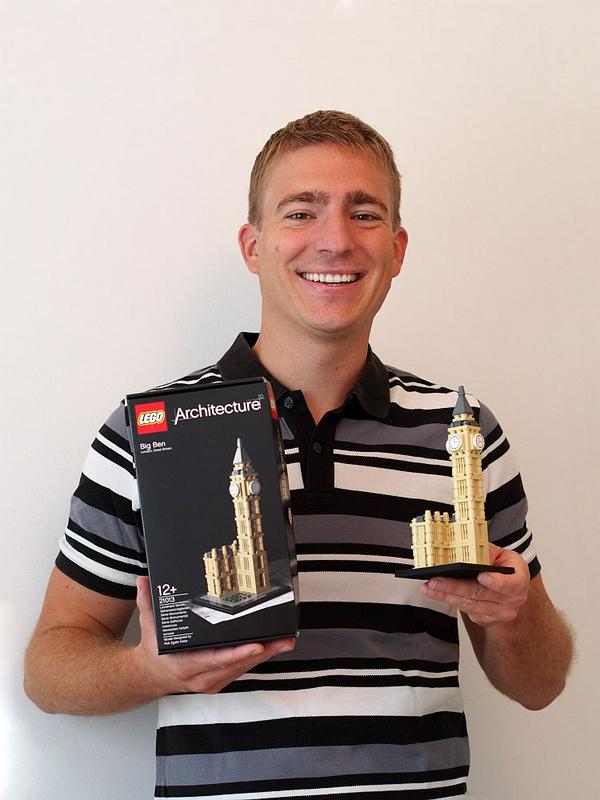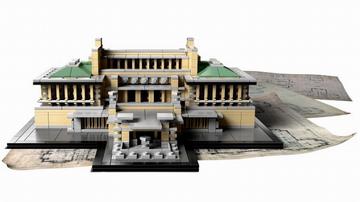

He designs models of globally famous buildings and landmarks for LEGO Architecture, a series devoted to the past, present and future of architecture. And the results of his work have thrilled all generations.
Rok Žgalin Kobe is the second "architectural artist" whose name is featured on the boxes of LEGO bricks. London’s Big Ben, Tokyo’s Imperial Hotel, the United Nations Headquarters in New York, Singapore’s Marina Bay Sands complex and Rome’s Fontana di Trevi are among the fascinating models designed by the Slovenian architect.
The beginnings of a successful working relationship
When LEGO published an open international competition for architects to participate in the development of the LEGO Architecture line, this big fan of LEGO bricks – indeed they were his favourite childhood distraction – applied and got the job: "It was my know-how, hard work, passion and a bit of luck that got me there," says Rok Žgalin Kobe. As a professional/scientific collaborator, he took an active part in the development of the LEGO Architecture Studio set, an ambitious product that combines brick play with serious designing and architectural reflections. The set is targeted at actual as well as aspiring architects.
Žgalin Kobe is presently in charge of research into other buildings and landmarks in terms of their suitability for LEGO design. He then develops the selected models through to the final stage, a process that has to meet many tough internal criteria, which is reflected in the final high-quality product. The Slovenian architect is proud of the fact that several of his own ideas have been realised by such a big company.
His works include the United Nations Headquarters model, whose unveiling on 20 September 2013 was a major event: it was indeed UN Secretary-General Ban Ki-moon himself who placed the final brick on the LEGO replica, an enlarged official LEGO United Nations set. Architect Žgalin Kobe explains that this project, one of the many proposed by him, was at first rejected. But as he was particularly enthusiastic about the idea, he made a model himself and presented it in the company. And that’s when it was accepted! "The model required only minimum corrections before production, so I am proud to say that the design was fully my own," says Žgalin Kobe. Another proof of his success is that the architecture series has remained in the annual portfolio of LEGO lines, which are otherwise changed pretty frequently.
Playing with bricks
And what are his current plans for the LEGO Architecture series? "Future products are, of course, a closely guarded secret, as are the selection criteria," says Žgalin Kobe coyly. But a particular personal challenge revolves around buildings whose architectural design seems difficult to transfer to LEGO bricks: "These would include Singapore’s Marina Bay Sands and the Eiffel Tower. And I would be happy to transfer Slovenian buildings, too," the architect points out. Does he have a personal favourite in the collection of models of buildings and landmarks that he has created? "The one I cherish most is Rome’s Fontana di Trevi; not only does it represent a certain evolution in the design of the line, but the original fountain and Rome have played a significant part in my personal life, too. Expecting our child, my wife and I were inspired to name our son after Remus, one of the brothers from Rome’s foundation myth. And the idea of transferring the fountain to LEGO form was materialised only a year later," relates Žgalin Kobe.
LEGO bricks are present not only in his work environment, but also at home, as he and his older son spend many an hour creating with them: "Through him, I revive my own memories, as we play with the models I got when I was I child myself. And there are still many years of play ahead, as my younger son will soon be joining in, too," says the Slovenian designer with pride.
Living between Slovenia and Denmark
Although architect Žgalin Kobe does most of his work for LEGO from Slovenia, he frequently visits Denmark. But his family home has remained in Slovenia. And what does he like best about Slovenia? "It offers a high quality of life that may actually exceed that in countries with theoretically higher standards. Slovenia offers a high level of education and is a very safe country. Its greatest advantage, though, is its excellent geographical position – the relative proximity of extremely diverse landscapes from the Alps to the Adriatic. This allows for quality and diverse free-time activities," concludes successful architect Žgalin Kobe. We are certain that he is already planning new landmark models to be transformed into tiny bricks. So who knows – maybe these will someday include Plečnik’s Triple Bridge, too?
Danila Golob, SINFO

























































